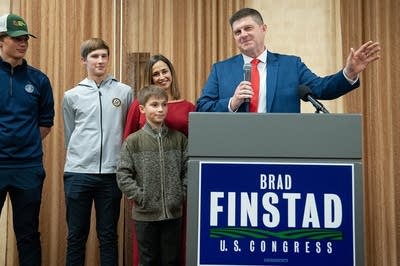'No red wave': Walz reelected Minnesota governor after sharp-elbowed race

Go Deeper.
Create an account or log in to save stories.
Like this?
Thanks for liking this story! We have added it to a list of your favorite stories.
Updated Nov. 9., 1:20 a.m.
DFL Gov. Tim Walz on Tuesday won a second term following a race for governor that featured deep divides and big bucks and tested the durability of one party and the viability of the other.
Twin Cities area voters turned out in big numbers for Walz, reinforcing a metro “blue wall” of support that more than countered Republican Scott Jensen’s strength in greater Minnesota.

The DFL also held onto the Minnesota House Tuesday and was making a strong run at flipping the state Senate, putting DFL control of the Legislature and the governor’s office within reach.
“Well, Minnesota, democracy is alive and well in this state,” Walz, his voice hoarse at the end of the campaign, told a DFL Party gathering. “There is no red wave.”
Turn Up Your Support
MPR News helps you turn down the noise and build shared understanding. Turn up your support for this public resource and keep trusted journalism accessible to all.
Jensen came out at around 11 p.m. at the main GOP gathering vowing to fight on, and saying that while his numbers were “disappointing” in Hennepin and Ramsey counties, he had hope for a rally as votes came in from greater Minnesota.
Jensen conceded at about 12:35 a.m. Wednesday, saying “Tim Walz is the governor for four more years.”
Observers expected the governor’s race to hinge on the size of margins Walz could run up in and around urban centers versus those Jensen could accumulate in rural communities, with the results in outer-ring suburbs and regional centers proving pivotal.
As vote totals poured after polls closed at 8 p.m., it appeared that Walz’s strength in the Twin Cities metro area would hold.
The vote for Walz delivered a fourth consecutive term for DFL governors, something unprecedented in state history.
Walz competed with Jensen and a cadre of lesser-known, third-party candidates during the summer and fall.
The top-of-the-ticket race was one of deep policy differences, sharp elbows and big bucks — $33 million and counting as of late October.
Walz was forced to play defense around his responses to COVID-19, police brutality cases that led to massive civil unrest and state Capitol gridlock.
While the unemployment rate hit a record low and a state surplus climbed to a record high on his watch, anxiety over soaring inflation complicated the Walz pitch for another four years.
“We know what the worries are. We know what the dangers are. But what our opponents have given us is the starkest contrast, the starkest contrast that we could ever see,” Walz said in one of his closing campaign stops. “They have given us a picture of Minnesota and they go out of their way to tell us Minnesota is broken.”

Jensen, a doctor and former state legislator, hoped voters would see the race as a referendum on the incumbent.
“You know that you've not heard anything from Tim Walz over the last 12 months about what are his successes,” Jensen said at a weekend rally ahead of the election. “Have you seen one ad that he ran about something he got done? Because he doesn't have anything to run on.”
But Jensen had to contend with problems of his own, some related to positions he took or comments he made.
Democratic groups hammered Jensen over remarks before he won the GOP nod that he would try to outlaw abortion; he softened that stance after a watershed U.S. Supreme Court ruling that eliminated federal abortion protections. And Walz and allies poked holes in his suggestion that Minnesota could ditch its income tax entirely.
Challenge and opportunity awaited the winner.
Despite fears of a recession, Minnesota is in a fiscally advantageous position. A massive surplus went mostly unused in the prior legislative session, allowing for ambitious tax-cut or spending plans when the governor submits a new two-year budget early in 2023.
But the Legislature, which prior to the election was closely split among Democrats and Republicans, was by most accounts headed for a makeover. After redistricting and a bevy of retirements, there was sure to be a slate of rookie lawmakers who on the whole are more ideologically driven than the people they will replace.
Both Walz and Jensen said they would honor the results of the election.
They ran starkly different campaigns.
Walz, 58, didn’t have a serious challenge from within his party for the nomination. That allowed him to amass a significant fundraising advantage and to launch a TV ad campaign in the middle of summer. Outside groups added millions more to the airwaves against Jensen.
Walz was more selective in his campaign appearances than his first governor campaign in 2018 and agreed to only a trio of debates.
Jensen, 67, had to navigate a crowded Republican field to win a convention endorsement en route to his party’s nomination. He staked out controversial positions around COVID-19 and on social issues, but he built up a sturdy following in his regular travels into greater Minnesota.
He narrowed the campaign money gap late in the race and finally got significant help from outside groups with just weeks to go.
Dear reader,
Political debates with family or friends can get heated. But what if there was a way to handle them better?
You can learn how to have civil political conversations with our new e-book!
Download our free e-book, Talking Sense: Have Hard Political Conversations, Better, and learn how to talk without the tension.









